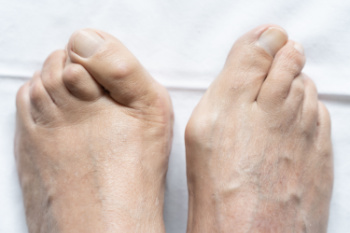Items filtered by date: August 2025
The Difference Between a Sprained and Broken Ankle

Ankle injuries are common, and it can be difficult to tell the difference between a sprain and a break. A sprained ankle occurs when the ligaments are stretched or torn, often from twisting or rolling the foot during sports or walking on uneven ground. A broken ankle, or fracture, happens when one or more bones in the ankle joint break, usually from a fall, direct impact, or severe twisting injury. Symptoms of both include pain, swelling, bruising, and difficulty walking. However, a break may cause more intense pain, visible deformity, or an inability to bear weight at all. The area might feel tender to the touch and appear misshapen or unstable. A podiatrist can perform a physical exam, take X-rays, and determine whether the injury is a sprain or fracture. Treatment may involve rest, bracing, targeted exercises, or, in some cases, surgery. If you have injured your ankle, it is suggested that you schedule an appointment with a podiatrist for appropriate treatment solutions.
Broken ankles need immediate treatment. If you are seeking treatment, contact Joseph Creswell, DPM from Practice. Our practitioner can provide the care you need to keep you pain-free and on your feet.
Broken Ankles
A broken ankle is experienced when a person fractures their tibia or fibula in the lower leg and ankle area. Both of these bones are attached at the bottom of the leg and combine to form what we know to be our ankle.
When a physician is referring to a break of the ankle, he or she is usually referring to a break in the area where the tibia and fibula are joined to create our ankle joint. Ankles are more prone to fractures because the ankle is an area that suffers a lot of pressure and stress. There are some obvious signs when a person experiences a fractured ankle, and the following symptoms may be present.
Symptoms of a Fractured Ankle
- Excessive pain when the area is touched or when any pressure is placed on the ankle
- Swelling around the area
- Bruising of the area
- Area appears to be deformed
If you suspect an ankle fracture, it is recommended to seek treatment as soon as possible. The sooner you have your podiatrist diagnose the fracture, the quicker you’ll be on the way towards recovery.
If you have any questions, please feel free to contact our office located in Wallace, ID . We offer the newest diagnostic and treatment technologies for all your foot care needs.
Managing Bunions

A bunion forms when the joint at the base of the big toe gradually shifts, creating a bony bump that can become sore, inflamed, and irritated by footwear. Podiatrists evaluate the degree of the deformity and tailor care to relieve discomfort and prevent it from worsening. Supportive shoes with ample toe space, cushioning to reduce rubbing, and custom orthotic inserts can help improve foot mechanics. Cold therapy and anti-inflammatory treatments may ease swelling and tenderness. In cases where pain limits activity or the bunion continues to progress, surgery may be recommended to realign the joint. Addressing the problem early often makes it easier to manage and helps maintain comfortable movement. If you have persistent pain or difficulty wearing shoes due to a bunion, it is suggested you arrange an appointment with a podiatrist for effective relief and management tips.
If you are suffering from bunions, contact Joseph Creswell, DPM of Practice. Our practitioner can provide the care you need to keep you pain-free and on your feet.
What Is a Bunion?
A bunion is formed of swollen tissue or an enlargement of boney growth, usually located at the base joint of the toe that connects to the foot. The swelling occurs due to the bones in the big toe shifting inward, which impacts the other toes of the foot. This causes the area around the base of the big toe to become inflamed and painful.
Why Do Bunions Form?
Genetics – Susceptibility to bunions are often hereditary
Stress on the feet – Poorly fitted and uncomfortable footwear that places stress on feet, such as heels, can worsen existing bunions
How Are Bunions Diagnosed?
Doctors often perform two tests – blood tests and x-rays – when trying to diagnose bunions, especially in the early stages of development. Blood tests help determine if the foot pain is being caused by something else, such as arthritis, while x-rays provide a clear picture of your bone structure to your doctor.
How Are Bunions Treated?
- Refrain from wearing heels or similar shoes that cause discomfort
- Select wider shoes that can provide more comfort and reduce pain
- Anti-inflammatory and pain management drugs
- Orthotics or foot inserts
- Surgery
If you have any questions, please feel free to contact our office located in Wallace, ID . We offer the newest diagnostic and treatment technologies for all your foot care needs.
Common Running Injuries and How to Protect Your Feet

Running is an excellent form of exercise, but it can lead to injuries if the feet and ankles are not properly supported. Common running injuries include Achilles tendonitis, which causes pain and stiffness along the back of the ankle, and plantar fasciitis, which creates sharp heel pain from inflammation of the foot’s arch. Prevention involves wearing supportive shoes, stretching regularly, gradually increasing mileage, and avoiding uneven terrain. A podiatrist can evaluate your gait, provide custom orthotics, recommend strengthening exercises, and treat injuries to restore comfort and mobility. Ignoring foot pain can lead to chronic issues. If you have developed a foot or ankle injury from running, it is suggested that you consult a podiatrist who can treat various foot conditions.
Exercising your feet regularly with the proper foot wear is a great way to prevent injuries. If you have any concerns about your feet, contact Joseph Creswell, DPM of Practice. Our practitioner will treat your foot and ankle needs.
How to Prevent Running Injuries
Many common running injuries are caused by overuse and overtraining. When the back of the kneecap starts wearing out and starts causing pain in your knee, this is commonly referred to as runner’s knee. Runner’s knee is a decrease in strength in your quadriceps and can occur if you’re not wearing properly fitted or supporting shoes. To prevent runner’s knee, focusing on hip strengthening is a good idea, as well as strengthening your quads to keep the kneecaps aligned.
What Are Some Causes of Running Injuries?
- One cause of a common running injury is called iliotibial band syndrome.
- Plantar fasciitis is also another common injury.
- Stress fractures can occur from overtraining, lack of calcium, or even your running style.
Best Ways to Prevent Running Injuries
- Wear footwear that fits properly and suits your running needs.
- Running shoes are the only protective gear that runners have to safeguard them from injury.
- Make a training schedule. Adding strengthening exercises as well as regular stretching can help keep you strong and limber and can lessen the possibility of injuries.
- Stretching keeps muscles limber; this will help you gain better flexibility.
If you have any questions, please feel free to contact our office located in Wallace, ID . We offer the newest diagnostic and treatment technologies for all your foot care needs.
Ankle Fracture? Don’t Wait for Treatment
Protecting Young Athletes’ Feet and Ankles While Cheerleading

Cheerleading places intense demands on the lower body, often leading to injuries such as ankle instability, Achilles tendinitis, and stress fractures in the ankle. These cheerleading foot injuries can result from repetitive jumping, hard landings, improper technique, or insufficient conditioning. Risk factors include weak ankle muscles, poor footwear, and training on hard surfaces. Symptoms include pain, swelling, or difficulty bearing weight. A podiatrist can evaluate these conditions, provide bracing, custom orthotics, and design rehabilitation plans to restore strength and prevent re-injury. If your cheerleader experiences foot or ankle pain, it is suggested that you consult a podiatrist, as prompt care is essential. This type of doctor can treat various foot and ankle injuries, and guide you on additional injury prevention tips.
Sports related foot and ankle injuries require proper treatment before players can go back to their regular routines. For more information, contact Joseph Creswell, DPM of Practice. Our practitioner can provide the care you need to keep you pain-free and on your feet.
Sports Related Foot and Ankle Injuries
Foot and ankle injuries are a common occurrence when it comes to athletes of any sport. While many athletes dismiss the initial aches and pains, the truth is that ignoring potential foot and ankle injuries can lead to serious problems. As athletes continue to place pressure and strain the area further, a mild injury can turn into something as serious as a rupture and may lead to a permanent disability. There are many factors that contribute to sports related foot and ankle injuries, which include failure to warm up properly, not providing support or wearing bad footwear. Common injuries and conditions athletes face, including:
- Plantar Fasciitis
- Achilles Tendinitis
- Achilles Tendon Rupture
- Ankle Sprains
Sports related injuries are commonly treated using the RICE method. This includes rest, applying ice to the injured area, compression and elevating the ankle. More serious sprains and injuries may require surgery, which could include arthroscopic and reconstructive surgery. Rehabilitation and therapy may also be required in order to get any recovering athlete to become fully functional again. Any unusual aches and pains an athlete sustains must be evaluated by a licensed, reputable medical professional.
If you have any questions please contact our office located in Wallace, ID . We offer the newest diagnostic and treatment technologies for all your foot and ankle needs.

